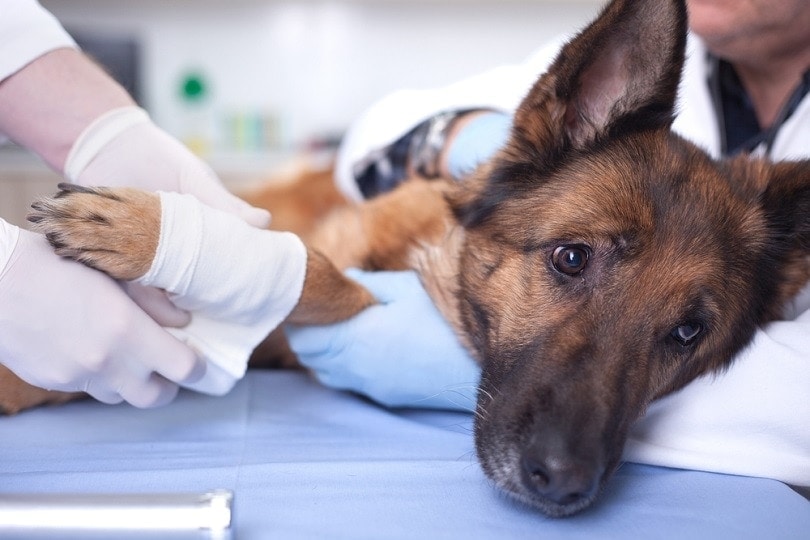In this article
Of all the things that could happen, your dog has to get a broken bone. Broken bones are painful in the physical sense and the financial sense. It’s not cheap to correct a fracture. But here’s the good news: It’s not the most expensive vet procedure either, and it’s typically not life-threatening. Depending on your dog’s fracture, you can move past this physical and financial setback within a few months.
That sounds like a long time, but the time passes quickly. So, how much does fixing your dog’s broken leg cost, and what can you expect after? As a general answer, the surgery cost for a dog’s broken leg will be from $2,000-$5,000 on average plus additional costs. But there a a lot of details you should know about, let’s find out.

Why Your Dog May Need Broken Leg Surgery
In the past, some broken bones just couldn’t be fixed. But now, most fractures can be repaired. It might surprise you that your dog needs surgery for a broken leg. After all, can’t a cast or splint do the job?
There are times when a cast and splint solve the problem. However, depending on where and how severe the break is, stainless steel pins or plates may be required to correct it. Otherwise, the bone may never heal properly.
Veterinarians recommend surgery based on the type of fracture your dog has, age, and other injuries your dog may have suffered. Veterinarians also consider any financial limitations you may have.

How Much Does Broken Leg Surgery Cost for Dogs?
- The location of the clinic
- The type of clinic
- The type of fracture your dog has
- The equipment the surgeon chooses to use
If your dog has a broken leg, you may have to go to an emergency hospital instead of a general practice clinic, and these office visits alone can cost anywhere between $60 to $200.
This doesn’t include the surgery, which can range from $2,000 to $5,000 or more, depending on the fracture. If your dog only needs a splint or cast, the cost shouldn’t exceed $1,000. However, you should expect to pay at least $2,000 if your dog’s leg requires surgery.
This price typically includes everything related to the surgery, such as IV catheter placement and fluids, anesthesia medication, surgical monitoring equipment, bloodwork, hospitalization, and X-rays.
Additional Costs to Anticipate
Your dog’s age, temperament, and overall health also affect how much the surgery will cost. Older dogs (or dogs with health complications) may be a little more expensive because they may require further pre-op health screenings, extra monitoring equipment, or different tools.
For example, the vet may need to monitor their blood pressure and blood work more closely. Your veterinarian may also need to use different medications based on your dog’s health and how your dog responds to the medicine. However, you shouldn’t worry if your dog is older. It just means that your veterinarian will need to make adjustments.
In addition, anxious or aggressive dogs can be difficult to handle and may bite if anyone tries to touch their leg. They may have to be sedated so the vet can examine the leg, adding a few extra dollars to the bill.
The point is that you should expect to pay a little more if your dog is a senior, has health complications, or has an anxious temperament.

General Practice vs Emergency Hospitals
Like in human medicine, there are general practice veterinarians, emergency hospitals, and specialists to help your dog. Your general practice veterinarian will refer you and your dog to a specialist if they need to see one for a more complicated fracture that requires a special procedure or tools.
If your dog’s broken leg occurs after hours or on a weekend, you may need to go to an emergency hospital. Emergency hospitals typically cost more simply for the convenience of their service.

Shelters and Low-Cost Clinics
Finding out your dog has a broken limb and being unable to fix it is a common struggle with pet owners. If you’re in this situation, call your veterinarian and ask about low-cost clinics or hospitals that offer payment plans.
Animal shelters and low-cost clinics typically don’t provide surgical services like fixing a broken limb, but low-cost clinics sometimes offer help with X-rays and bloodwork. So, even if you can’t pay for the entire procedure out of pocket, you may be able to find support for the other expenses.
Thankfully, many vet offices accept Care Credit if getting a medical credit card interests you.

What to Do for Your Dog After Surgery
So, what does life look like after your dog has undergone surgery? Post-operative care looks different for every dog. It depends on your dog’s age, the type of fracture, and if your dog has other health conditions.
After surgery, your dog must spend an extra day or two at the hospital for post-operative care. This ensures your dog wakes up from anesthesia comfortably and that vitals are normal before being sent home. Veterinarians also want to ensure the surgical site doesn’t become infected and that all the pins and plates stay in place.
The day you pick your dog up from the hospital is exciting. But staying focused and listening to the vet’s instructions is also essential. A detailed list of at-home instructions for caring for your dog will be sent home with you.
- Strict bed rest
- How your dog can safely move around the house
- A specialized diet depending on how your dog feels after surgery
- How to give pain medications, antibiotics, and anti-anxiety meds (and what they do to help your dog)
Knowing how long your dog will be on bed rest is difficult to estimate. Every surgery and fracture is different and requires various healing periods. Generally, you can expect your dog to return to everyday life after 3 or 4 months.
If you need veterinary advice over your dog’s recovery, we recommend speaking with a vet.
How Often Should I Follow Up With My Vet?
How often you follow up with your vet depends on how your dog heals during post-op. You should expect to visit your vet several times for bandage changes, mobility checks, X-rays, and potentially pin removal. This doesn’t include physical therapy. Your doctor will tell you if more follow-up appointments are necessary.

Does Pet Insurance Cover Dog Broken Leg Surgery?
Absolutely! Accidents happen to all of us, and pet insurance is there to help. Pet insurance will reimburse you for most of the procedure if you go through the waiting period before the accident occurs. Every pet insurance company offers different reimbursement rates and monthly prices. It’s wise to research the best pet insurance companies and select one that provides the ideal coverage for your budget.

Conclusion
Broken limbs are painful, and they’re not cheap to fix. However, broken bones heal, and your pup will be on the road to recovery. Of all the worst-case scenarios, a broken bone isn’t too bad. It can cost an arm and a leg, but the $2,000 price tag is better than other pet care treatments. You can always ask for help from your veterinarian, friends, and family. Take a deep breath, pick up the phone, and call around. There are people who want to help.
Featured Image Credit: VP Photo Studio, Shutterstock




















2 Responses
My 1 year old toy poodle broke her left front leg when she unexpectedly jumped out of my arms from an SUV. You must get the leg fixed within 24 to 72 hours for it to be effective. We were out of town and it was a Saturday., so my daughter's vet straighten as best she could and put her leg in a splint ($1240). She told us we needed to get a vet surgeon to fix it. which cost $6200. He was great and said that he has fixed over 100 toy poodles' legs. We were able to apply for Care Credit which was great. We will pay interest free 12 payments of $500. Also, note we had to pay $260 every two weeks (3 times) to change her cast and $500 for a final X-ray to make sure it was healed.
Oh no, I’m so sorry to hear about your toy poodle’s injury! That sounds like a really stressful situation, especially with being out of town and needing to act so quickly. It’s great that you found a skilled surgeon who had experience with toy poodles and could help get her leg fixed properly. I know the costs can really add up with an injury like that, but it sounds like you handled it as best you could, and it’s good to hear that Care Credit helped make it more manageable.
It’s a lot of time, effort, and money, but I’m sure it’s all worth it to get her back to being her happy, healthy self. We really appreciate you sharing your story with us, Sandra. I hope your pup gets well soon. 🙂